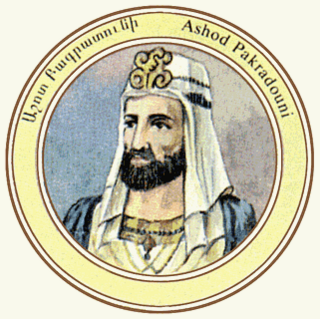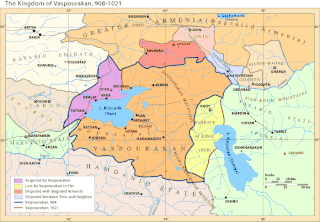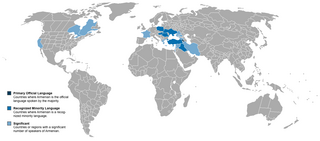The Artsruni were an ancient noble (princely) family of Armenia.

The Macedonian dynasty ruled the Byzantine Empire from 867 to 1056, following the Amorian dynasty. During this period, the Byzantine state reached its greatest expanse since the Muslim conquests, and the Macedonian Renaissance in letters and arts began. The dynasty was named after its founder, Basil I the Macedonian who came from the Theme of Macedonia which at the time was part of Thrace.

Ashot I was an Armenian king who oversaw the beginning of Armenia's second golden age. He was known as Ashot the Great and was the son of Smbat VIII the Confessor and was a member of the Bagratuni Dynasty.

Gagik I was the king of Armenia who reigned between 989 and c. 1017/20, under whom Bagratid Armenia reached its height, and "enjoyed the accustomed experience of unbroken peace and prosperity."

Hakob Melik Hakobian, better known by his pen name Raffi, was an Armenian author and leading figure in 19th-century Armenian literature.
Western Armenia had been under Byzantine control since the partition of the Kingdom of Armenia in AD 387, while Eastern Armenia had been under the occupation of the Sassanid Empire starting 428. Regardless of religious disputes, many Armenians became successful in the Byzantine Empire and occupied key positions. In Sassanid-occupied Armenia, the people struggled to preserve their Christian religion. This struggle reached its culmination in the Battle of Avarayr. Although the battle was a military defeat, Vartan Mamigonian's successor, Vahan, succeeded to force the Persians to grant religious freedom to the Christian Armenians in the Nvarsak Treaty of 484.
The Siunia also known as the Siak or Syunik were a family of ancient Armenian nobles who were the first dynasty to govern as Nakharars in the Syunik Province in Armenia from the 1st century. The Nakharars were descendants of Sisak.

Vahan Artsruni is a modern Armenian rock musician, singer, composer and artist.
Ashot IV Bagratuni, better known as Ashot Msaker, reputedly for his refusal to refrain from eating meat during Lent, was an Armenian prince from the Bagratid family. A fugitive from the failed uprising in 775 against Arab rule in Armenia, where his father was killed, over the next decades he gradually expanded his domains and established a predominant role for himself in the country's affairs, becoming recognized by the Abbasid Caliphate as presiding prince of Armenia from 806 until his death in 826.
Tovma Artsruni was a ninth-century to tenth-century Armenian historian and author of the History of the House of Artsrunik. Contrary to the given title, the four-volume work not only relates the history of Artsruni royal family, of which he was a member of, and its origins near Lake Van but also comprehensively covers the history of Armenia.

Grigor Artsruni was an Armenian journalist, critic, writer and public activist, Doctor of Political Economy and Philosophy. Since 1872 he had been publishing the Mshak magazine being its editor and manager until his death.

The Kaysite dynasty was a Muslim Arab dynasty that ruled an emirate centered in Manzikert from c. 860 until 964. Their state was the most powerful Arab amirate in Armenia after the collapse of the ostikanate of Arminiya in the late 9th century.

Vaspurakan was the first and biggest province of Greater Armenia, which later became an independent kingdom during the Middle Ages, centered on Lake Van. Located in what is now called eastern Turkey and northwestern Iran, the region is considered to be the cradle of Armenian civilization.

Gagik I Artsruni was an Artsruni ruler of Vaspurakan in southern Armenia, first as prince of northwestern Vaspurakan and after that until his death as king, claiming also the title of "King of Armenia" from the Bagratid line.
Senekerim-Hovhannes Artsruni, also known variously as Senekerim-John, Sennecherim or Sennacherib-John, known in Byzantine sources simply as Senachereim, was the sixth and last King of Vaspurakan, from the Artsruni dynasty. In 1021/22, he surrendered his kingdom to the Byzantine emperor Basil II, receiving in return extensive lands in the Empire, and the governorship of Cappadocia.
Gagik Apumrvan Artsruni was an Armenian prince of the Artsruni line. In 887 he was installed as regent of Vaspurakan and guardian of the three under-age sons of Grigor-Derenik Artsruni, but ended up usurping their place. In the end, as the dispossessed princes sought Muslim aid, Gagik secured the support of the Armenian king, Smbat I Bagratuni, and in 896/7 was formally recognized as prince of Vaspurakan. He ruled until he was killed in 898 by the middle of the three brothers, Gagik, and was succeeded by Gagik's eldest brother, Ashot-Sargis Artsruni.
Vard Mamikonian was an Armenian nobleman from the Mamikonian family. He served as the marzban of Persian Armenia from 505/510 to 509/514.
Catholicosate of Aghtamar was an independent see of the Armenian Apostolic Church that existed for almost eight centuries, from 1113 to 1895 and was based in the Cathedral of the Holy Cross on the Aghtamar Island near Van, in present-day Turkey.
Artsruni, an ancient Armenian noble family.









